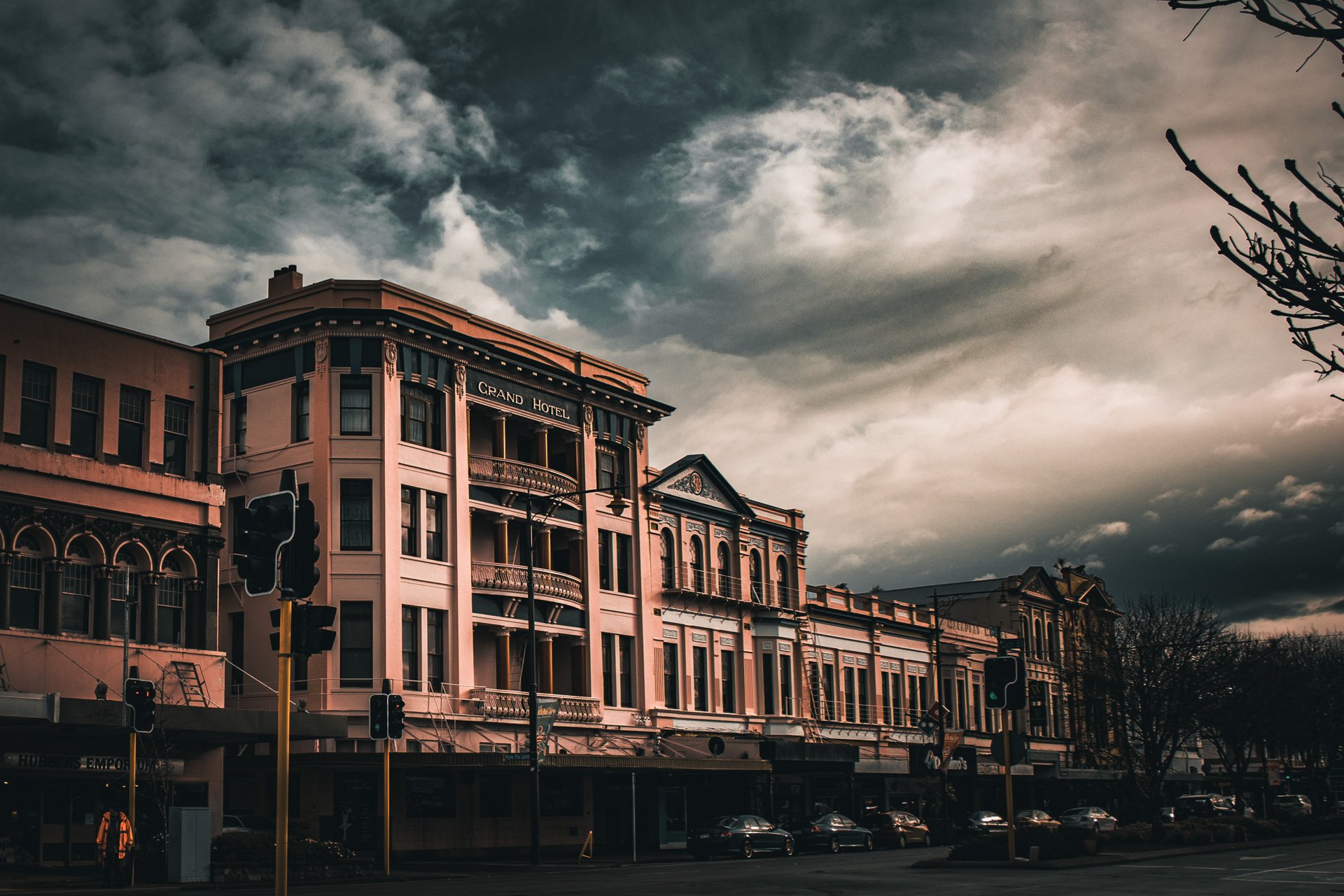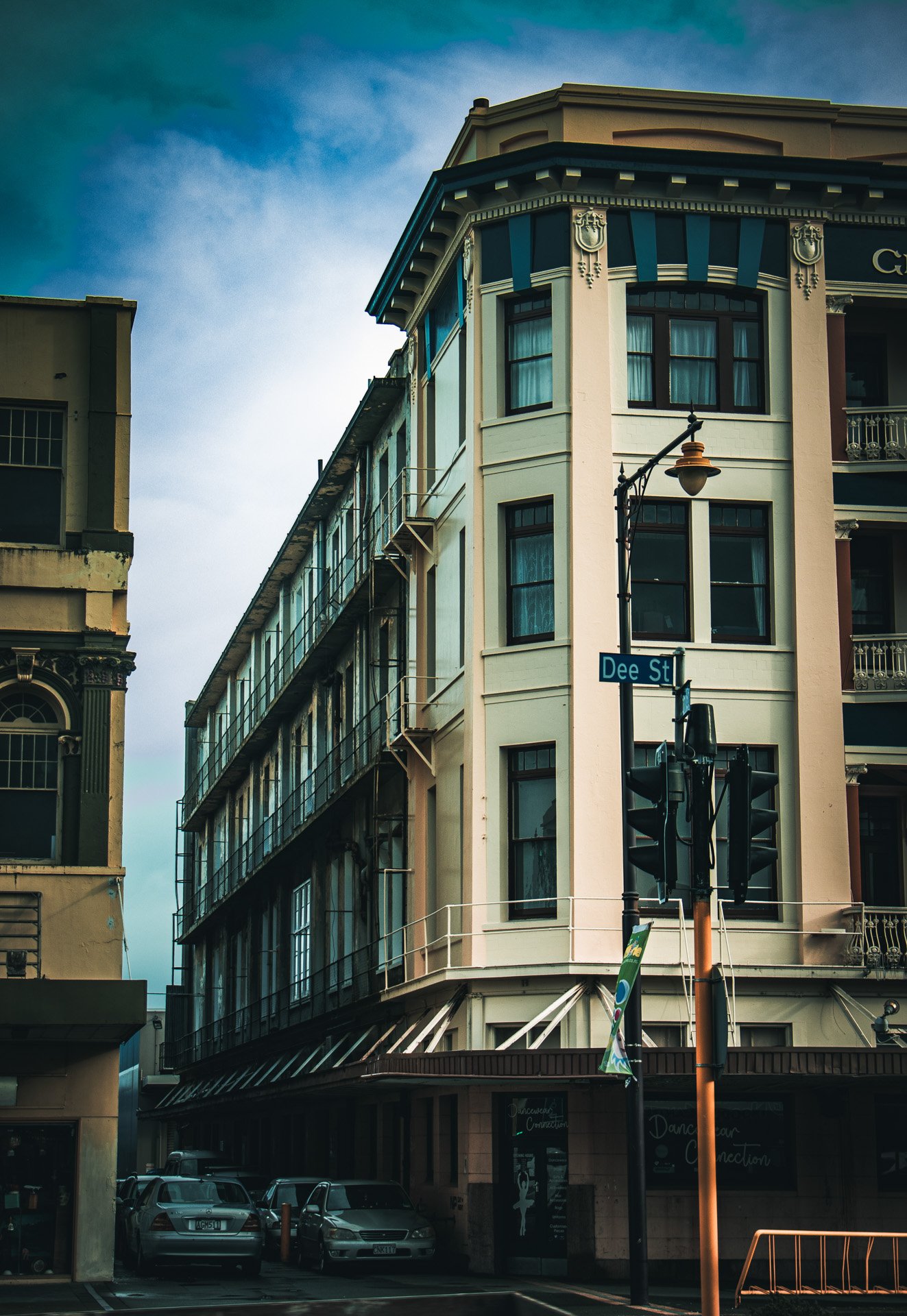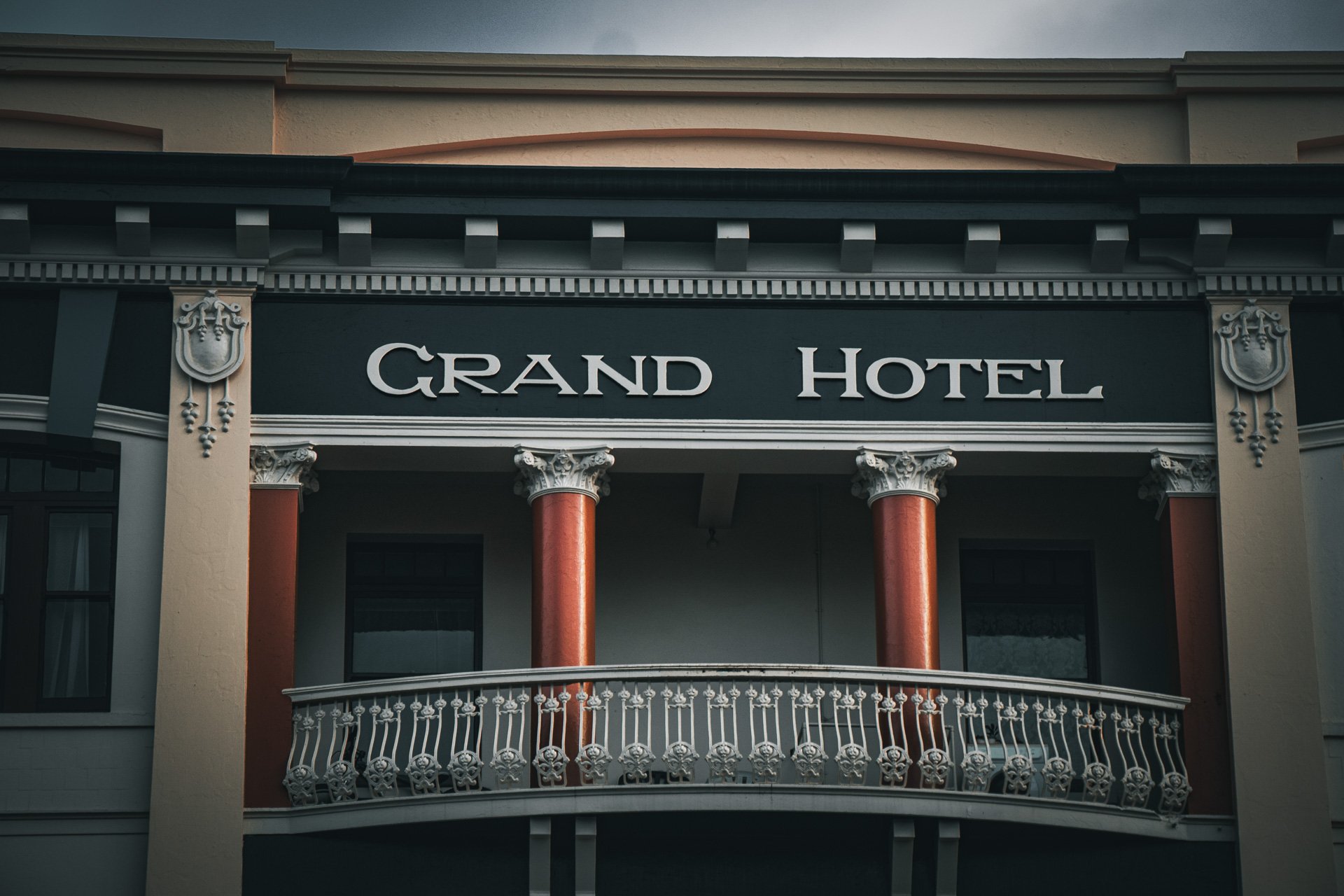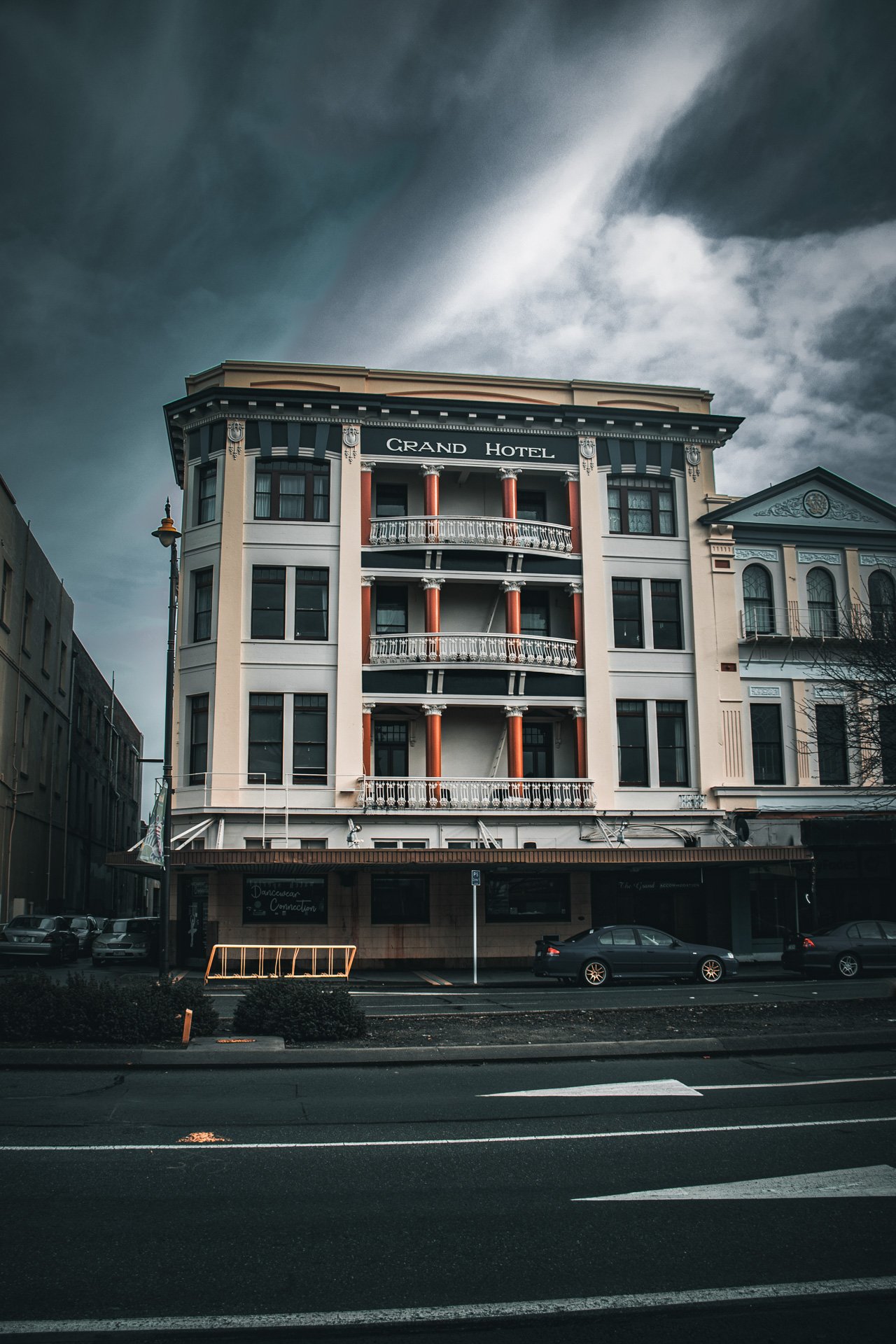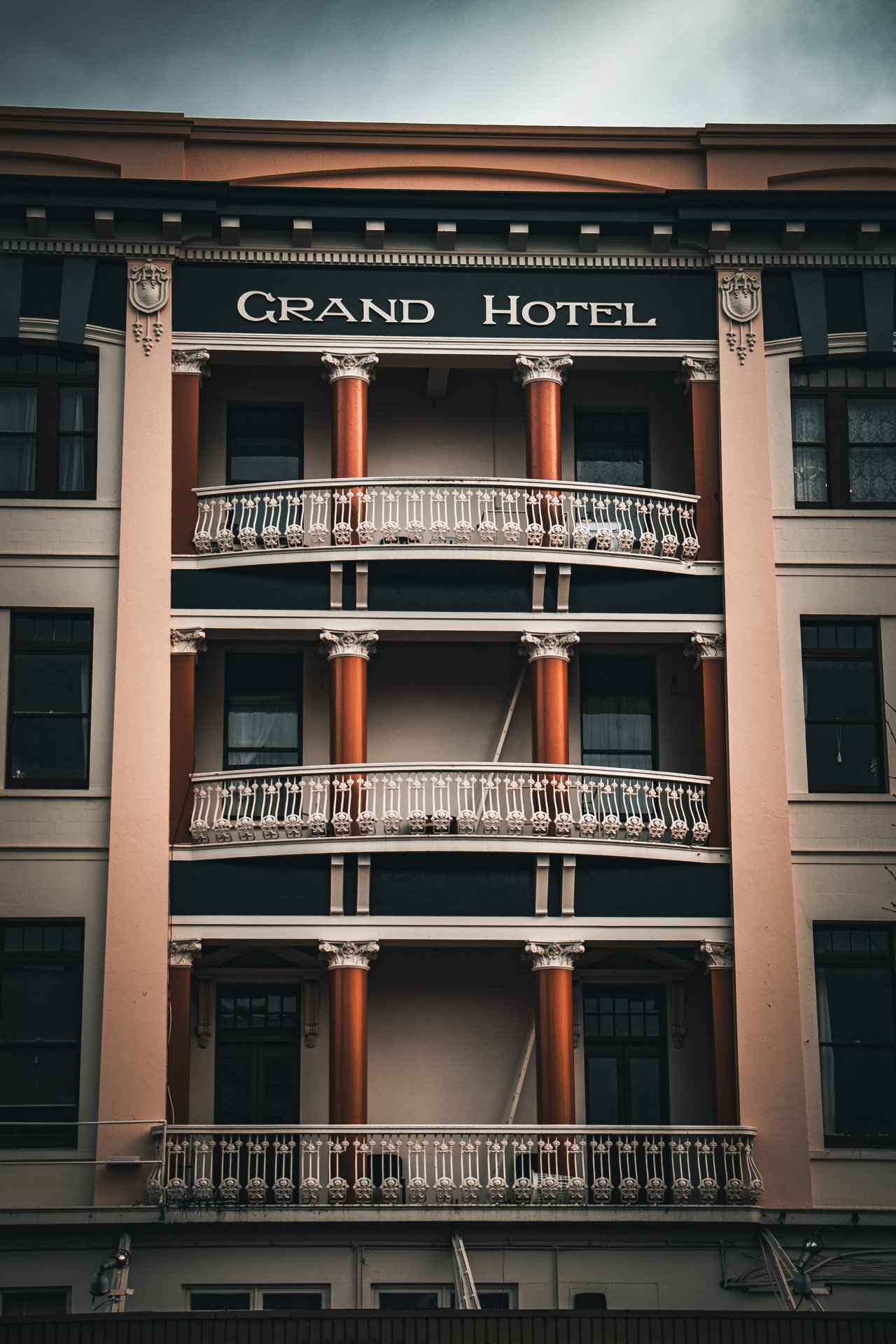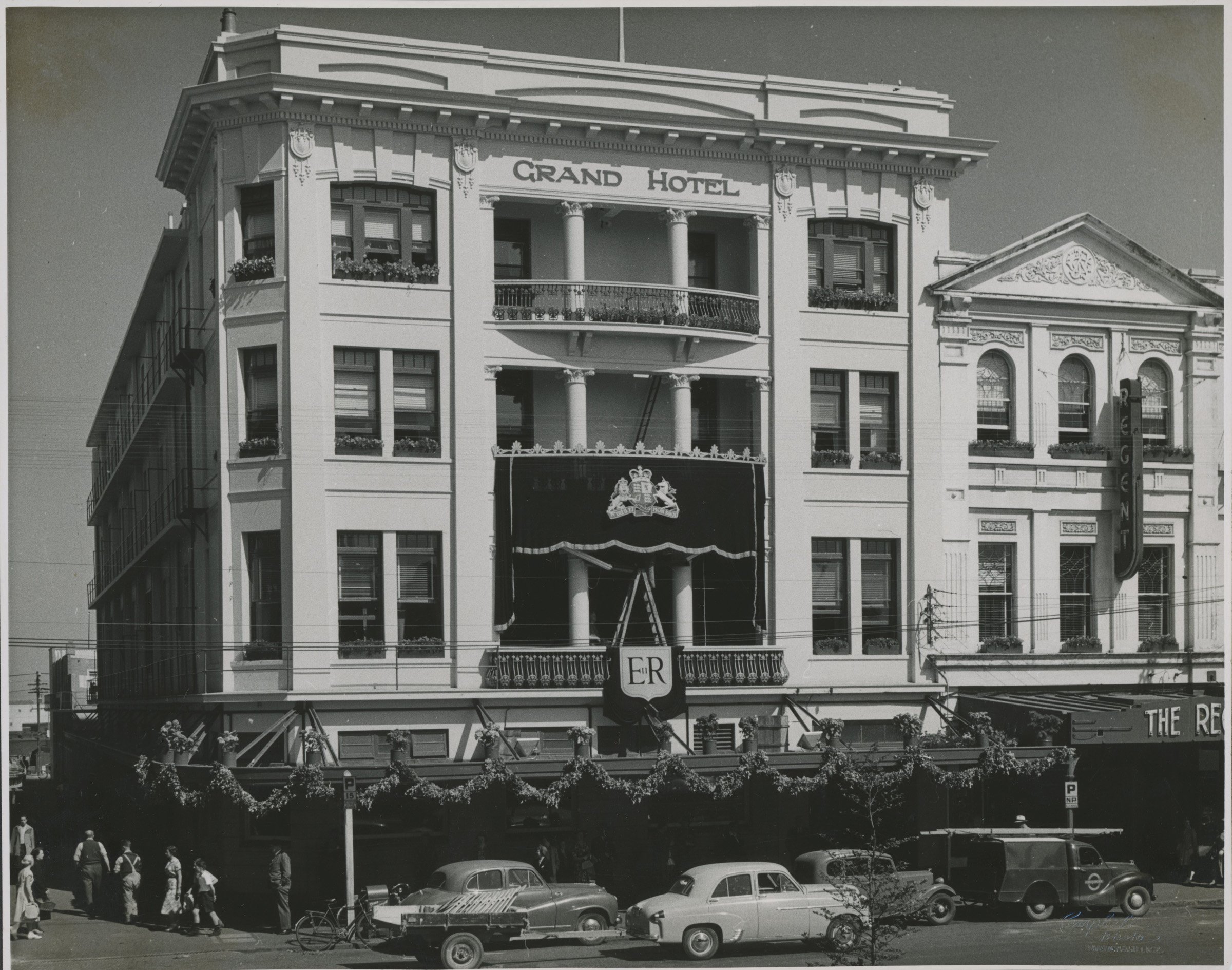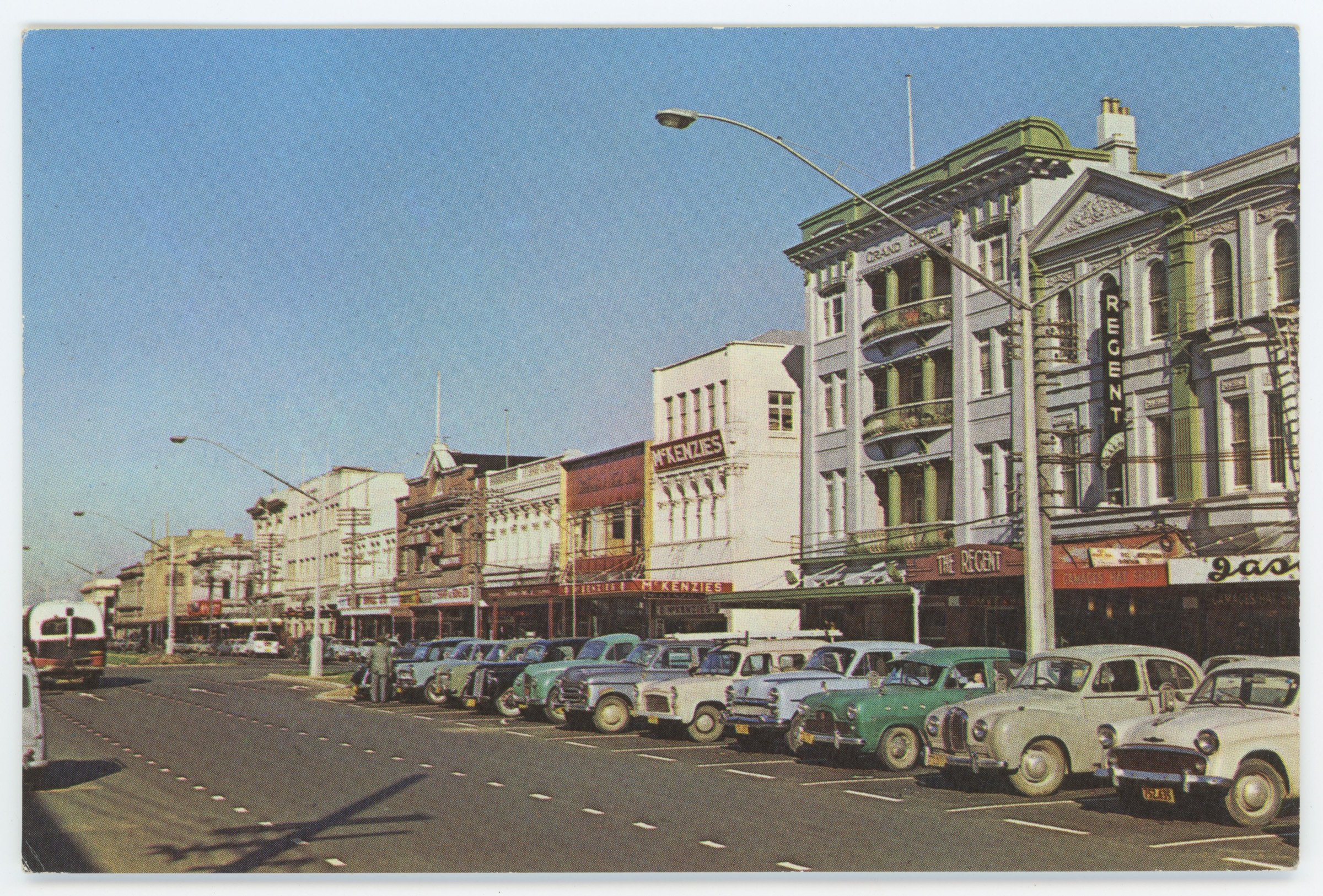
Invercargill City Council Archives, Ref: A0603 S27550007
Former Grand Hotel
Lot 3 DP341371
The Grand Hotel is one of Invercargill’s most iconic heritage buildings and has stood proudly on Dee Street since it was built in 1912-1913. It plays a special role in the city’s architectural and social history. During its history, it has served a diverse clientele from royalty to those in need of a home, even as a boutique hotel for a few short years, and it continues to stand as a testament to the evolving landscape of Invercargill. The Grand Hotel is celebrated for its grandeur and role as a community landmark with involvement in community and social projects.
-
76 Dee Street
Dee Street Historical Area -
Architect: C.J. (Cuthbert John) Brodrick
Builder: Mr A.J (Alf) Ball - building contract £8,000
Permit: Issued on September 4th, 1911
The site of The Grand Hotel in Dee Street has boasted a hotel since the early days of Invercargill when bullocks and carts were a common sight. The first was The Robert Burns Hotel, licenced around 1860 but was replaced by The Prince of Wales in 1862.
The Prince of Wales was built for William Livesey from timber cut by pit sawyers in Southland. It was a large, handsome two-storied wooden structure with a verandah and balcony, which provided a good vantage point for viewing parades, processions and daily activities on Dee Street.
It was a popular hotel for passengers waiting to leave for Melbourne on a steamer vessel from Bluff as it was close to the railway station and was used as a coaching station by Cobb & Co. It was also popular with the locals with the common refrain ‘Meet me at the Prince’ heard around the streets of Invercargill.
Livesay put it up for sale in 1866, eventually being sold the following year. Even though it had a succession of proprietors, it remained a favourite gathering place for the local community. Southland farmers knew to meet there when they came to town, it was the venue for the A&P Society meetings and also saw inquests and public meetings being held there. It was a shock to many when it was one of seven hotels closed after losing their liquor licenses following the Reduction Poll of 1894.
The old Prince of Wales hotel was sold for removal on the 10th of September 1910 by William Todd & Co for £73, to make way for the new hotel.
“And now, the good old Prince has to go to make room for a more noble structure.” Mr Wm. Todd
History.
Invercargill City Council Archives, Ref: A0010 S00780088 - Campbell’s Studio
Construction of the new hotel, owned by the Prince of Wales Propriety Company, and whose members included the architect C.J Brodrick, began in 1912. It was considered a bold move to build a new hotel when Invercargill was a no-license town, however upon completion, it was described in the local newspapers as palatial and one of the most important building ventures in Invercargill.
The first proprietor was Mr R Galbraith, previous proprietor of the Albion Hotel, which at the time of The Grand opening, had ceased trading as a hotel and had been converted to office space.
The ground floor was leased as offices and shops and in December 1912 the initial tenants included:
W.G Gilchrist the chemist
Mr Rodie, a sports outfitter
Southland Farmers Cooperative Association occupied the corner position next to the alleyway, selling houses and land
Mr Brennan ran the brand new billiard saloon at the western end of the building and they were joined by W.E Wright & Co. the following year, a hairdresser, tobacconist and newsagent.
On the 1st floor was a spacious dining room that could seat over 100 diners. There was also a writing room, commercial room, and drawing room, along with a parlour and lounge, and staff were accommodated in rooms at the back.
The 2nd & 3rd floors had spacious bedrooms with parlours facing Dee Street and tiled bathrooms with shower and spray baths. The hotel had electricity throughout and C.J Brodrick had an electric lift installed
The first resident was Mr J.B Thomson, who became a permanent resident, living there for over 50 years. He was also a member of the group that owned the Grand Hotel.
Prohibition was voted out of Invercargill in 1943 after 37 years of no-license and a lobby group campaigned for new outlets to be owned by a community trust. This led to the formation of the Invercargill Licensing Trust in 1944 and the Grand Hotel was purchased as their flagship hotel, opening for business on 1st March 1945.
Invercargill City Council Archives, Ref: A0010 S27260003
Stories.
Millars and Bakers.
Annie Cleland Millar was the founder and driving force behind the well-known local bakery firm A.C Millars Ltd, later known as Millar Lange after merging with Lange Bros. Annie Cleland was born near Glasgow, Scotland in 1855, coming to Invercargill in her 20s as a companion help to the family of the Colonial bank manager. She met John Millar, a self-employed baker and they married in January 1885, going on to have 9 children.
Around 1893, with husband John’s business failing, Annie became manager of the Prince of Wales private hotel, providing the family with live-in accommodation. The Prince was the main eating house in town with many farmers basing themselves there because of the proximity to the sale yards. The story goes that on weekly sale days, when the meal at The Prince was ready, the sale stopped and the crowd flocked through the alleyway and into the dining room.
After seven years at The Prince, Annie and the family moved when she took up the lease at The Coffee Palace, just across the road from the Post Office on Dee Street. The Coffee Palace was a tearoom, an oyster saloon and a bakehouse, and Annie made a success of it, mainly selling cakes and yeast goods.
In 1910 ACM Ltd became a private company with Annie and two of her sons, George and Andrew becoming directors. When the Federal Tearooms came up for lease the next year, Annie could see the potential but with only lukewarm support, she took it on in her name alone and made a huge success of it.
The Federal Tearooms, right next to the Grand Hotel became known as the place to go for tea parties, wedding breakfasts and society dinners. It was the venue of the celebration of the electric tramway opening in 1912, with the official party including the mayor of Invercargill William Ott and building-owner and Prime Minister Sir Joseph Ward. The family company took over the reins from Annie in 1913 and remained in their ownership until 1936.
The Famous Tea Loaf Incident
During the Great War, when sugar and dried fruits were in short supply, ACM Ltd began producing a type of bread called the tea loaf. The local breadmakers were unhappy with this move into what they considered their territory and responded by stopping the supply of loaves to make their sandwiches. Undeterred, the firm elected to make their own bread and this was to become a mainstay of their business.
Annie died on 28th March 1939 at her home in Bowmont Street, aged 84. She had established her very successful business, which remained in family hands and managed by Annie’s sons and grandsons until 1993.
The Most Famous Visitor.
Queen Elizabeth II and Prince Philip arrived in New Zealand on the SS Gothic just before Christmas 1953, beginning a five-week tour of the country. This was the Queen’s first royal tour following her Coronation in June 1953, and she became the first reigning British monarch to visit Australia and New Zealand. New Zealanders loved it and it’s estimated that 2 out of 3 people saw the royal couple during this visit.
The royal entourage crisscrossed the country, arriving in Southland at the end of the tour on Thursday 28th of January 1954. The royal couple stopped for lunch at H&J Smiths Department Store in Gore before travelling to Invercargill and The Grand Hotel. Their arrival was planned with military precision and Invercargill was decked out with banners, bunting and floral displays. They spent two nights at The Grand Hotel, greeting the public from the 2nd-floor balcony twice on Friday evening.
The hotel had been spruced up for the royal visit. Their suite of rooms had been repainted in pale green, cream and gold, a new carpet was laid, and they also brought in a new bed. The Southland Art Gallery selected several pieces of art from the collection by New Zealand artists to be displayed on the walls in their suite.
One of the Queen’s last official duties of the tour was to deliver a farewell message to the nation. She did this from her private sitting room at the Grand Hotel via two microphones set up specifically for the broadcast. She commented that their stay had been pleasant and memorable and that they had enjoyed every minute of it.
As the royal party left The Grand Hotel on Saturday morning to join the SS Gothic at Bluff, they were serenaded with the traditional Scottish folk song, Will Ye No Come Back Again. Among those waving them off were close to 100 children from the Highland Dancing Association, dressed in their costumes lining the street to join in the singing.
Recollections of the Queen
Elizabeth Miller, the much-loved Invercargill children’s librarian of the 1970s and 80s and then Dreamweaver storyteller, was 18 years old in 1954 and working at The Grand Hotel, earning money for training college. She remembers being vetted by the police, wearing very unattractive white smocks as uniforms and being taught how to curtsey.
In these Southland Oral History Project recordings, she recounts personal anecdotes of Queen Elizabeth staying at the hotel.
Southland Oral History Project. H0271 http://archives.ilibrary.co.nz/repositories/4/resources/1077
Sandwiches for the Queen
The Queen’s Napkin
If you want to listen to a podcast about the Queen’s visit to Invercargill, you can listen to it here
Invercargill City Council Archives, Ref: A0637 S27880058 G.Goodall
Useful links
